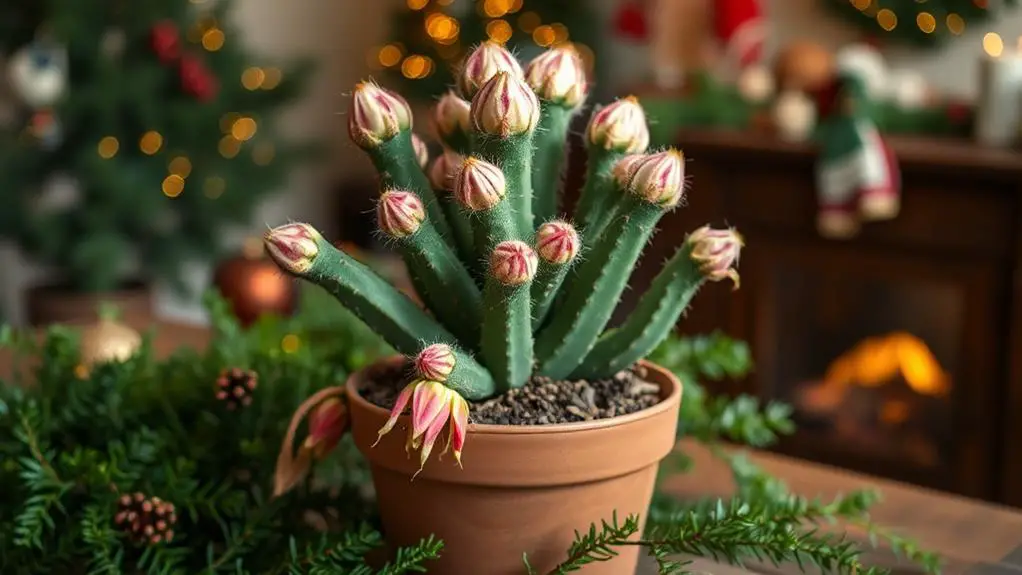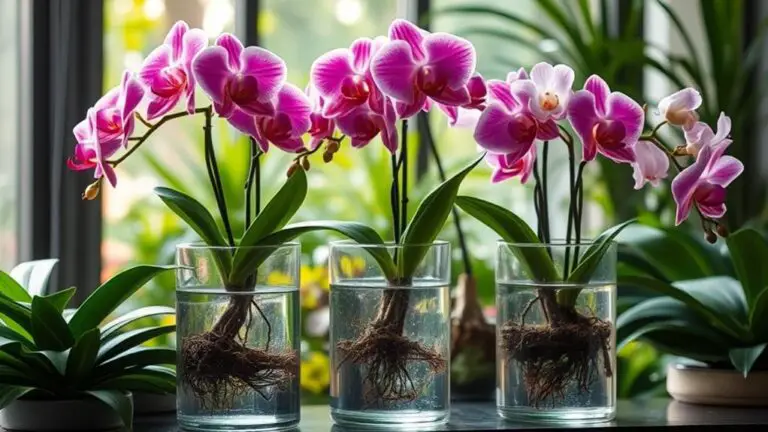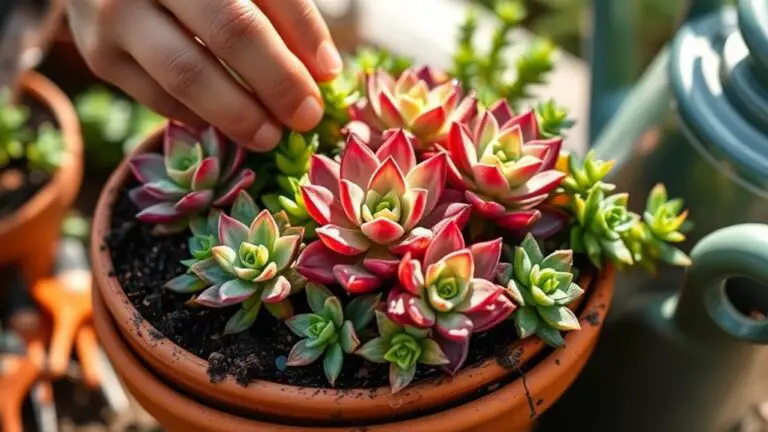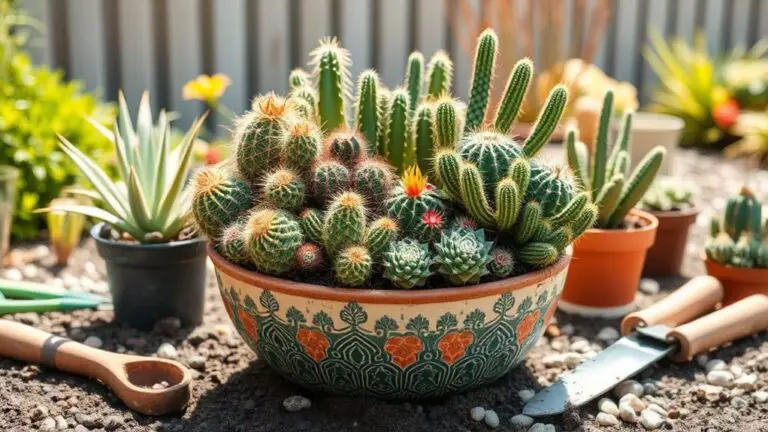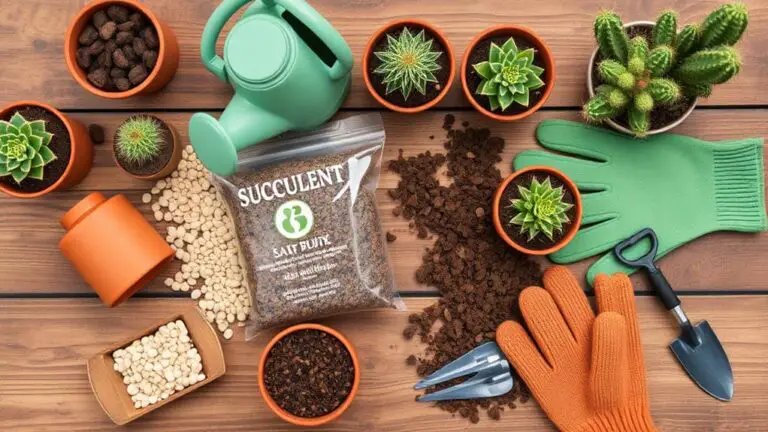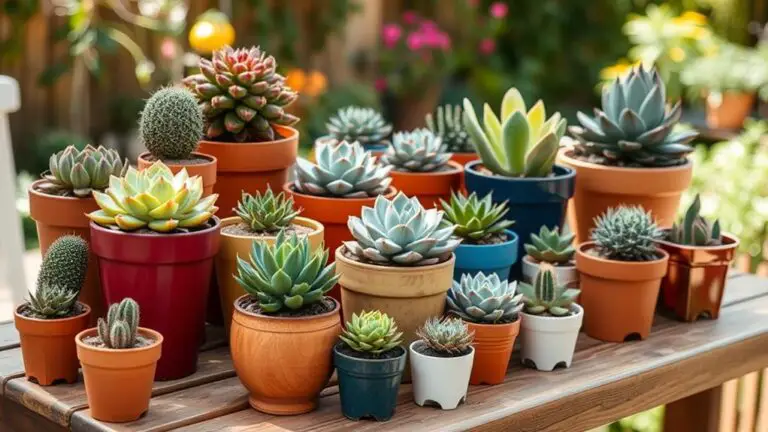Why Is My Christmas Cactus Dropping Buds and Flowers?
You might be wondering why your Christmas cactus is dropping its buds and flowers, and the reasons could be more varied than you'd expect. Abrupt changes in the environment, such as temperature shifts or exposure to cold drafts, can shock the plant into shedding its blooms. Insufficient light and improper watering practices also play significant roles in this issue. While it might seem overwhelming, understanding these common causes can help you take the right steps to guarantee a healthy blooming cycle. So, what can you do to address these problems and keep your Christmas cactus thriving? Let's explore.
Common Causes of Bud Drop
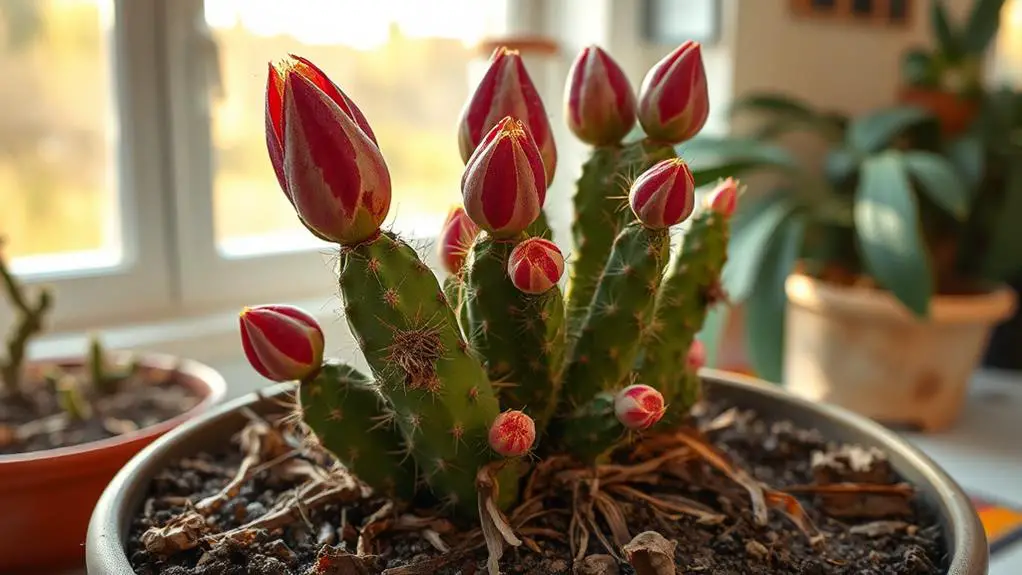
When your Christmas cactus starts dropping buds, abrupt environmental changes are often to blame.
Moving your plant from a greenhouse to your home can stress it out, leading to bud drop. Cold drafts from open windows or doors can also cause your cactus to lose its buds. Make sure it's away from heaters, too, as hot air can be just as harmful.
Insufficient light is another culprit. Your Christmas cactus needs enough light, especially when forming buds. Place it in a well-lit spot, but avoid direct sunlight.
Finally, keep an eye on your watering habits. Over-watering or under-watering can stress the plant, making it drop buds.
With the right care, you'll help your cactus thrive.
Impact of Environmental Changes
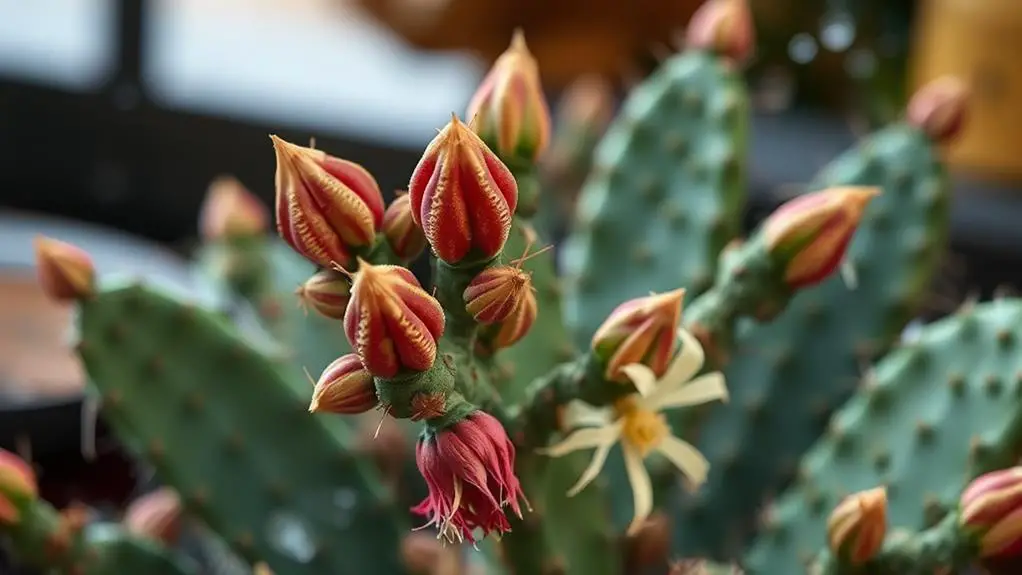
Environmental changes can have a profound impact on your Christmas cactus, often leading to issues like bud drop.
When you move your plant from a greenhouse to your home, it can experience shock from differences in temperature, humidity, and care. Exposure to temperature fluctuations, such as cold air or drafts, can destabilize your cactus and cause it to lose flower buds.
Dry indoor air, especially during winter, adds to the stress, increasing the likelihood of bud shedding. To prevent this, try to maintain stable humidity levels above 50% and avoid sudden environmental changes.
Importance of Proper Lighting
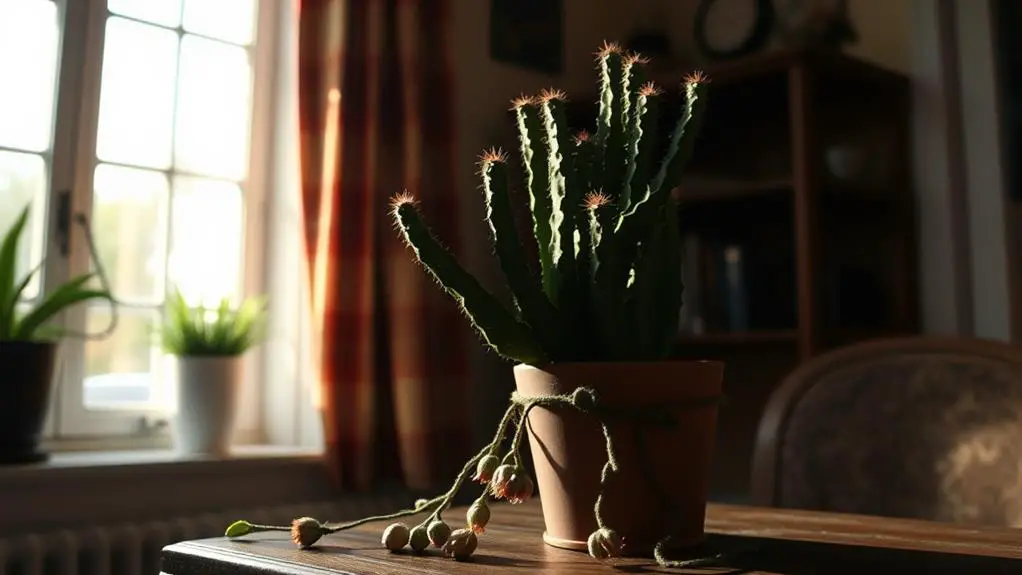
Proper lighting is key to a healthy Christmas cactus.
You'll need to give it 14 hours of darkness each night from September to November to help it form buds, while also ensuring it gets bright, indirect light during the day.
Be careful not to expose it to direct sunlight, as this can harm the leaves.
Darkness Requirement Timing
To guarantee your Christmas cactus thrives and blooms beautifully, understanding the timing of its darkness requirement is essential. Your plant needs 14 hours of darkness each night from September to November to form flower buds. During the day, it requires 10 hours of light conditions, mimicking its natural habitat's filtered light.
Ensuring the right light and dark schedule helps your cactus grow strong and develop flowers. If the light conditions are wrong, it won't photosynthesize properly, affecting bud formation.
Here's a simple schedule to follow:
| Time | Light Condition |
|---|---|
| 6 AM – 4 PM | Bright, indirect light |
| 4 PM – 6 AM | Complete darkness |
Avoid Direct Sunlight
Ensuring your Christmas cactus avoids direct sunlight is essential for its health and vibrant blooms.
Christmas cacti need bright light, but direct sunlight can scorch their leaves and stress the plant, leading to buds dropping. In their natural habitat, they thrive under the canopy of trees, enjoying filtered light.
You should place your cactus in a spot with indirect light for at least 10 hours a day. Sudden exposure to harsh lighting, like putting it near a sunny window, can cause stress and bud drop.
Maintaining appropriate light levels not only helps with current blooms but also promotes overall plant health and future blooming cycles.
Light During Day**
While keeping your Christmas cactus away from direct sunlight is essential, understanding its light needs during the day is equally important. Your cactus thrives on bright, indirect light for about 10 hours daily. This type of light exposure helps prevent bud drop and promotes healthy growth. Mimicking the cactus's natural environment, which includes filtered light, is key.
| Light Condition | Importance |
|---|---|
| Bright indirect light | Supports photosynthesis |
| Direct sunlight | Causes leaf burn |
| Insufficient light | Leads to weak growth |
Ensure your cactus gets the right amount of light to avoid bud drop. Remember, once buds form, regular light conditions are fine. Paying attention to these lighting needs will keep your Christmas cactus healthy and vibrant throughout the season.
Ideal Temperature Conditions
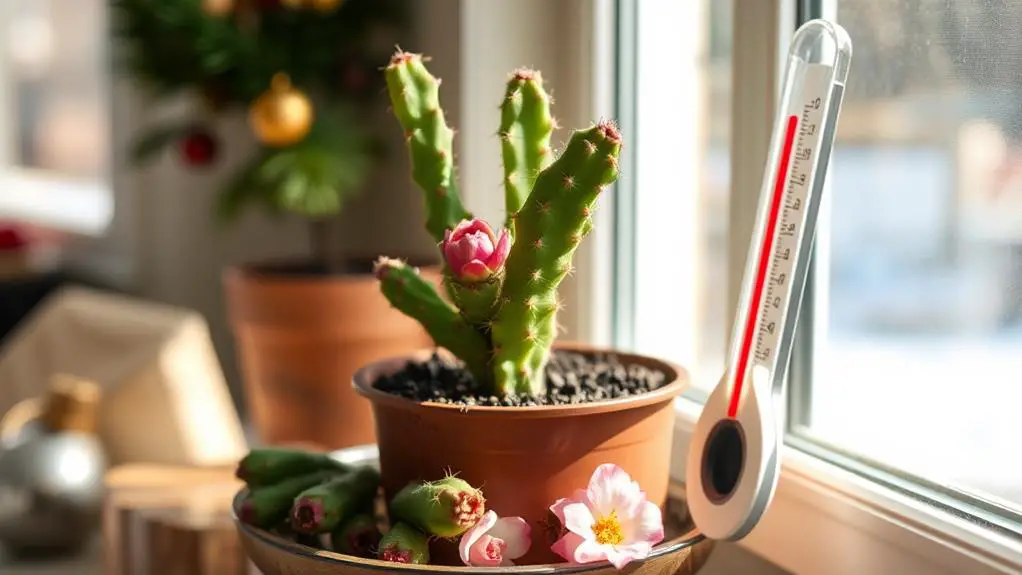
For Christmas cacti to flourish, they need to be kept in temperatures between 60°F and 80°F (15°C – 26°C).
Keeping the temperature stable within this range helps prevent bud drop and creates ideal conditions for growth. If temperatures rise above 90°F (32°C), your plant can experience stress, leading to bud drop.
It's also important to avoid sudden temperature changes, like moving your cactus from a cool environment to a warmer one. This can shock the plant and cause buds to fall off.
During the blooming period, cool nighttime temperatures between 50°F and 60°F (10°C – 15°C) are beneficial for stimulating bud formation.
Moisture and Watering Practices
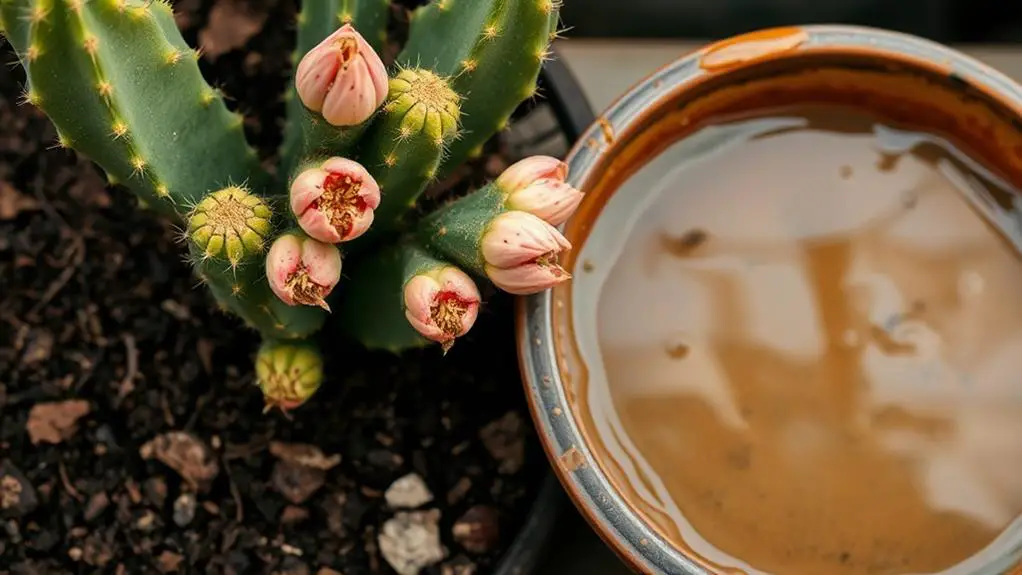
Maintaining proper moisture levels is key to keeping your Christmas cactus healthy and vibrant. Unlike typical cacti, it needs more moisture. Water only when the top inch of soil feels dry to the touch. Overwatering leads to root rot, a major cause of bud drop. Confirm your pot has drainage holes to let excess water escape. During winter dormancy, reduce watering to match the plant's lower moisture needs. This prevents stress that can cause bud loss. Use room temperature water to avoid shocking the plant. Consistent watering practices are essential to prevent both overwatering and underwatering, guaranteeing a healthy cactus and successful blooming.
| Tip | Action |
|---|---|
| When to water | Top inch of soil feels dry |
| Preventing root rot | Confirm pot has drainage holes |
| Winter watering | Reduce frequency during dormancy |
Soil and Fertilization Needs
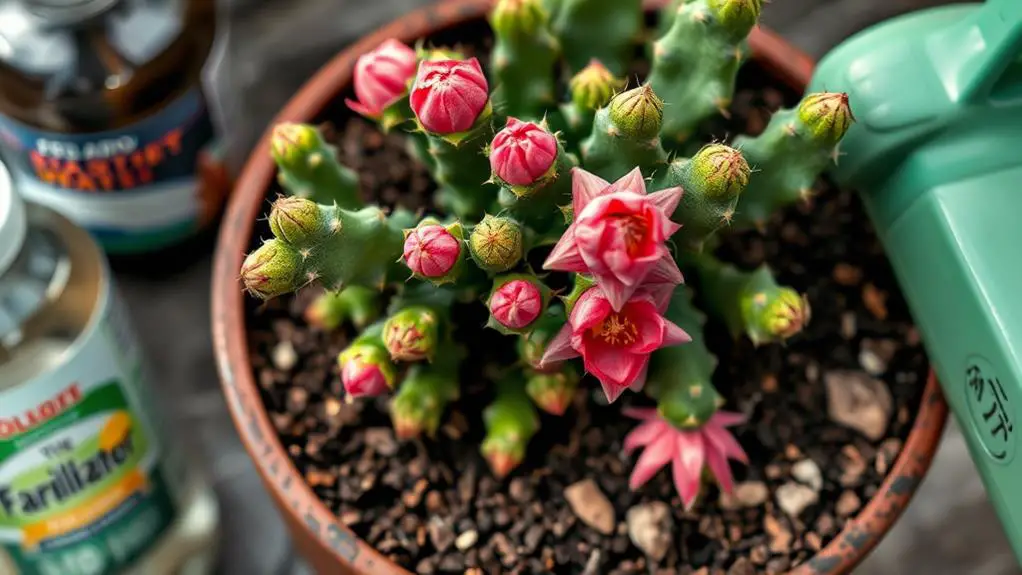
Just as proper watering practices are essential, your Christmas cactus also thrives in the right soil and with appropriate fertilization.
Use a well-draining, porous soil mix with a slightly acidic to neutral pH (5.5 to 6.2). This helps prevent root rot and allows the cactus to absorb nutrients effectively.
Over-fertilizing can cause a buildup of salts, damaging roots and leading to bud drop. During the blooming period, avoid fertilizing to reduce stress.
After blooming, use a diluted flowering houseplant fertilizer. Monthly fertilization with a balanced mix during the growing season supports healthy growth and blooming.
Be cautious when repotting to prevent transplant shock. Always use suitable soil to maintain your cactus's health and bud retention.
Managing Pests and Diseases
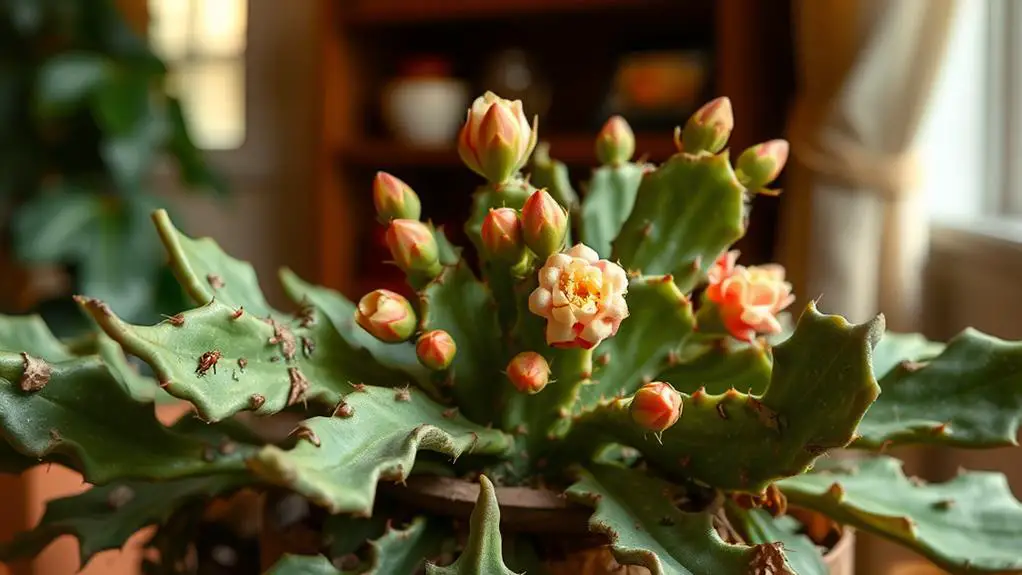
Keeping your Christmas cactus healthy means staying vigilant against pests and diseases. Regularly inspect your plant for common pests like spider mites, mealybugs, and aphids. These pests can weaken your cactus and cause bud drop.
Guarantee good air circulation and remove any dead or decaying foliage to reduce pest attraction. If you find an infestation, treat it promptly with insecticidal soap or neem oil, following the label instructions carefully.
Also, watch for fungal diseases such as gray mold and root rot, often resulting from overwatering. Maintain proper soil moisture and drainage to prevent these issues.
Quarantine new plants for a few weeks before adding them to your collection to avoid spreading pests and diseases.
Optimal Humidity Levels
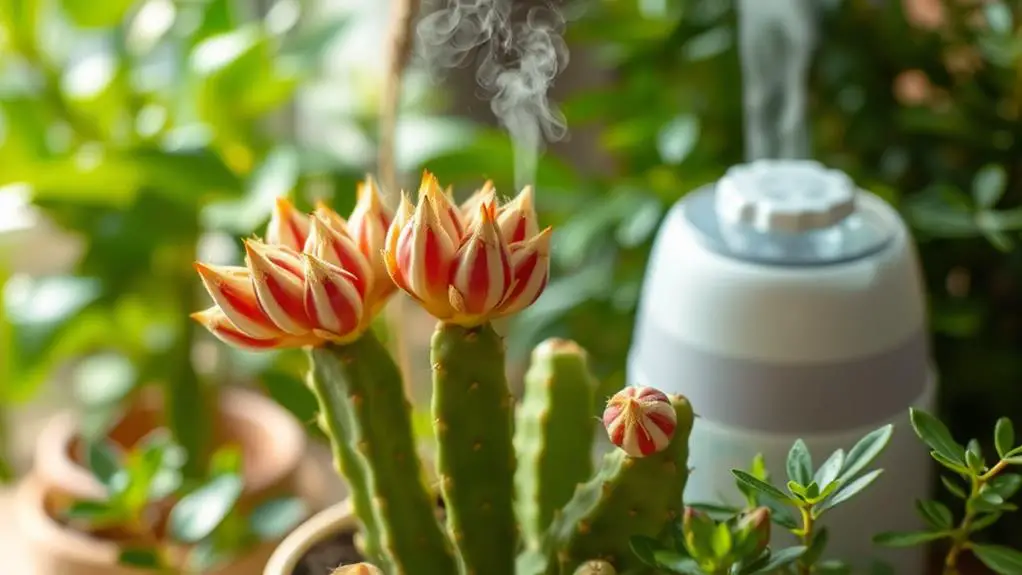
To guarantee your Christmas cactus thrives, you'll need to pay close attention to humidity levels. Since it's a tropical plant, it loves humidity levels above 50%. When indoor air gets dry, especially in winter, your cactus could face stress and bud drop. You can easily increase humidity by placing a pebble tray filled with water under the pot or regularly misting your plant. Just make sure water doesn't sit on the leaves to avoid rot. Maintaining stable humidity, especially from September to November when buds form, is essential for healthy blooms. Here's a quick guide:
| Method | Description | Benefit |
|---|---|---|
| Pebble Tray | Tray with water under pot | Increases humidity |
| Regular Misting | Light spritz on leaves | Supports growth |
| Humidifier Use | Device that adds moisture to air | Keeps air humid |
| Grouping Plants | Place plants together | Creates humid microclimate |
| Avoid Drafts | Keep away from vents | Prevents drying out |
Following these tips will help your Christmas cactus stay healthy and vibrant!
Seasonal Care Tips
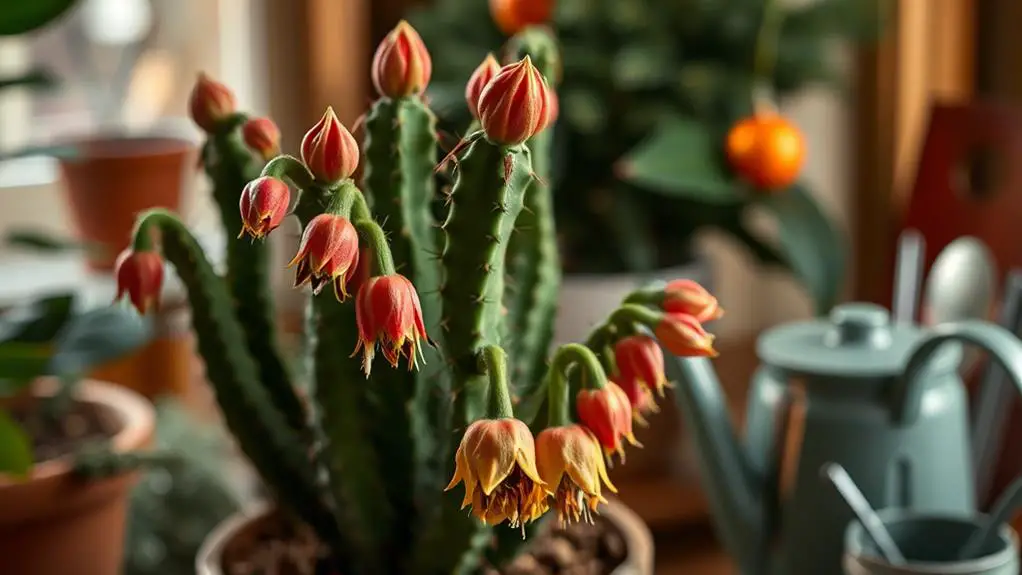
Fall is an important time for your Christmas cactus because it needs stable conditions to form buds, so try not to move or repot it.
In winter, keeping the air humid around your plant helps prevent bud drop, so mist it regularly or use a pebble tray.
With these steps, you'll support your cactus through these critical seasons.
Fall Bud Formation
One of the most essential phases in caring for your Christmas cactus is the fall bud formation period. To encourage a healthy Christmas cactus bud, you need to provide 14 hours of darkness each night starting October 1.
Maintaining stable temperatures between 60°F and 70°F helps prevent stress, which can cause bud drop. Avoid sudden changes in environment like moving the plant indoors after summer too abruptly.
During the day, give your cactus bright, indirect light but keep it away from harsh sunlight. Regularly check the soil moisture to guarantee it stays slightly moist, not soggy.
Winter Humidity Maintenance
Maintaining adequate humidity during winter is essential for your Christmas cactus's health. These tropical plants thrive in humidity levels above 50%, and the dry indoor air from heating systems can cause them to drop buds.
To keep your cactus happy, try these tips:
- Pebble tray: Place a tray filled with water and pebbles under the pot to let evaporation boost humidity.
- Regular misting: Lightly mist the leaves, but avoid water in the joints to prevent rot.
- Grouping plants: Keep multiple plants together to create a humid microclimate as they release moisture.
- Use a humidifier: Especially in winter, a humidifier can maintain the right environment.
Follow these steps, and your Christmas cactus will thank you with beautiful blooms!
Reblooming Techniques
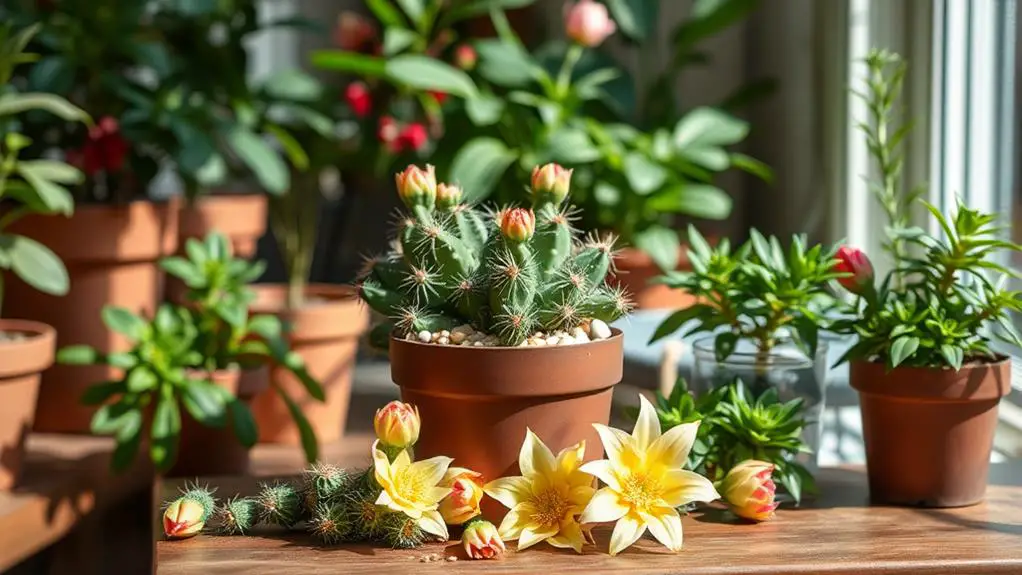
To successfully encourage your Christmas cactus to rebloom, you should focus on creating the right conditions post-bloom. First, use the right reblooming techniques by providing cooler temperatures, around 60-70°F (15-21°C), to stimulate bud formation. Ensuring 14 hours of darkness each night starting October 1 is key. This light regimen will trigger the flowering cycle and reduce bud and flower drop. Keep the soil slightly drier during the rest period to let your plant recharge. Gradually shift back to brighter light for healthy growth and blooms. Regularly check for stress or environmental changes, as stability is essential. Here's a quick guide:
| Technique | Condition | Timing |
|---|---|---|
| Cooler Temperatures | 60-70°F (15-21°C) | Post-bloom |
| Darkness | 14 hours each night | Starting October 1 |
| Drier Soil | Slightly dry | After blooming |
| Light Shift | Gradual return | After rest period |
| Stress Check | Regular monitoring | Throughout process |
With these steps, your Christmas cactus will thrive!
Frequently Asked Questions
How Do I Stop My Christmas Cactus From Dropping Buds?
To stop your Christmas cactus from dropping buds, keep temperatures between 60-70°F, maintain humidity above 50%, water evenly, darken it for 14 hours nightly from September to November, and avoid moving or exposing it to drafts.
Why Are the Buds on My Cactus Falling Off?
Your cactus buds might be falling off due to abrupt environmental changes, insufficient light, improper watering, temperature fluctuations, or pests. Ascertain consistent care, adequate light, and monitor for pests to keep your cactus healthy.
Should I Water My Christmas Cactus When It Has Buds?
Yes, you should water your Christmas cactus when it has buds. Make certain the top inch of soil is dry before watering. Keep the soil slightly moist and use room temperature water to avoid shocking the plant.
Why Are Parts of My Christmas Cactus Falling Off?
Your Christmas cactus may lose parts due to abrupt changes in environment, overwatering, insufficient light, temperature fluctuations, or pests. Guarantee stable conditions and proper care to prevent stress and promote healthy growth.
Conclusion
You can keep your Christmas cactus blooming beautifully by paying attention to its needs. Make sure it has stable temperatures, proper lighting, and consistent watering. Remember, avoiding sudden changes and drafts is key. Don't forget to check for pests and maintain the right humidity. With a bit of care and patience, your cactus will thrive, and you'll enjoy its lovely flowers for many seasons. Keep at it—you've got this!

